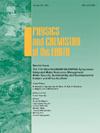喜马拉雅西北部塔威盆地季风性洪涝灾害综合光学与SAR数据分析
IF 3
3区 地球科学
Q2 GEOSCIENCES, MULTIDISCIPLINARY
引用次数: 0
摘要
季风强迫显著影响洪水灾害,强烈和持续的季风降雨通过迅速增加河流流量和压倒排水系统而加剧洪水风险,特别是在基础设施无计划或土地利用改变的地区。在本研究中,为了在风险评估方面定义洪水灾害区划(FHZ),采用层次分析法(AHP)技术整合不同的主题层,并确定标准在地理信息系统(GIS)环境中的相对重要性。FHZ结果表明,该地区103.81 Km2(3.50%)被FHZ划分为非常高风险区,617.17 Km2(20.82%)、865.87 Km2(29.21%)、1119.42 Km2(37.77%)、257.73 Km2(8.70%)被FHZ划分为高风险区、中危区和低危区。此外,为了验证基于GIS数据的FHZ区域,对基于合成孔径雷达(SAR)的洪水区域后向散射图像进行了两次标定。通过对SAR数据的预处理、洪水前照片的变化检测分析、洪水图像阈值分割以及使用谷歌Earth Engine (GEE)创建洪水淹没图,揭示了约216.37 km2的洪水淹没区域。研究结果表明,借助光学和基于sar的技术,可以实现洪水危害评估、减灾战略和快速灾后管理。本文章由计算机程序翻译,如有差异,请以英文原文为准。
Integrated optical and SAR data analysis for the monsoonal flood hazard mapping in the Tawi Basin Northwest Himalaya
Monsoon forcing significantly impacts flood hazards, intense and prolonged monsoon rains exacerbate flood risks by rapidly increasing river discharge and overwhelming drainage systems, especially in regions with unplanned infrastructure or altered land use. In the study, to define Flood Hazard Zonation (FHZ) in terms of risk assessment, the Analytical Hierarchy Process (AHP) technique was employed to integrate different thematic layers and ascertain the relative importance of criteria in the Geographic Information System (GIS) environment. The FHZ results shows that 103.81 Km2 (3.50 %) of the region was classified as very high-risk by the FHZ, while 617.17 Km2 (20.82 %), 865.87 Km2 (29.21 %), 1119.42 Km2 (37.77 %), and 257.73 Km2 (8.70 %) were classified as high-risk, medium-risk, and low-risk. Further, Synthetic Aperture Radar (SAR) based backscatter images of the floodwater area were demarcated for two periods in order to validate the FHZ area based on GIS data. Furthermore, an inundation region of roughly 216.37 km2 was revealed by pre-processing SAR data, change detection analysis of pre-flood photos, flood-image thresholding, and the creation of flood inundation maps using Google Earth Engine (GEE). The findings showed that flood hazard evaluations, mitigation strategies, and quick post-flood management could be achieved with the help of both optical and SAR-based techniques.
求助全文
通过发布文献求助,成功后即可免费获取论文全文。
去求助
来源期刊

Physics and Chemistry of the Earth
地学-地球科学综合
CiteScore
5.40
自引率
2.70%
发文量
176
审稿时长
31.6 weeks
期刊介绍:
Physics and Chemistry of the Earth is an international interdisciplinary journal for the rapid publication of collections of refereed communications in separate thematic issues, either stemming from scientific meetings, or, especially compiled for the occasion. There is no restriction on the length of articles published in the journal. Physics and Chemistry of the Earth incorporates the separate Parts A, B and C which existed until the end of 2001.
Please note: the Editors are unable to consider submissions that are not invited or linked to a thematic issue. Please do not submit unsolicited papers.
The journal covers the following subject areas:
-Solid Earth and Geodesy:
(geology, geochemistry, tectonophysics, seismology, volcanology, palaeomagnetism and rock magnetism, electromagnetism and potential fields, marine and environmental geosciences as well as geodesy).
-Hydrology, Oceans and Atmosphere:
(hydrology and water resources research, engineering and management, oceanography and oceanic chemistry, shelf, sea, lake and river sciences, meteorology and atmospheric sciences incl. chemistry as well as climatology and glaciology).
-Solar-Terrestrial and Planetary Science:
(solar, heliospheric and solar-planetary sciences, geology, geophysics and atmospheric sciences of planets, satellites and small bodies as well as cosmochemistry and exobiology).
 求助内容:
求助内容: 应助结果提醒方式:
应助结果提醒方式:


